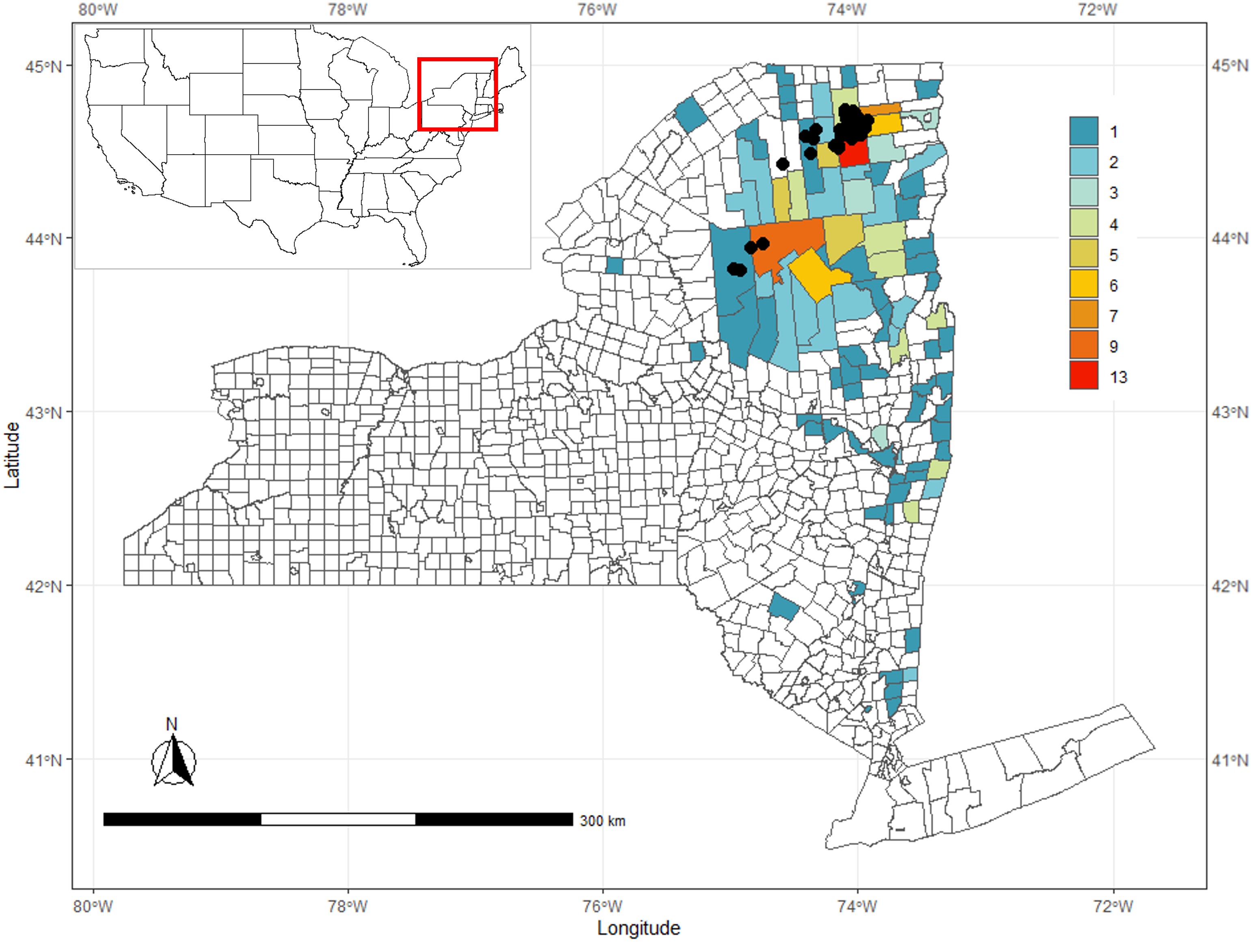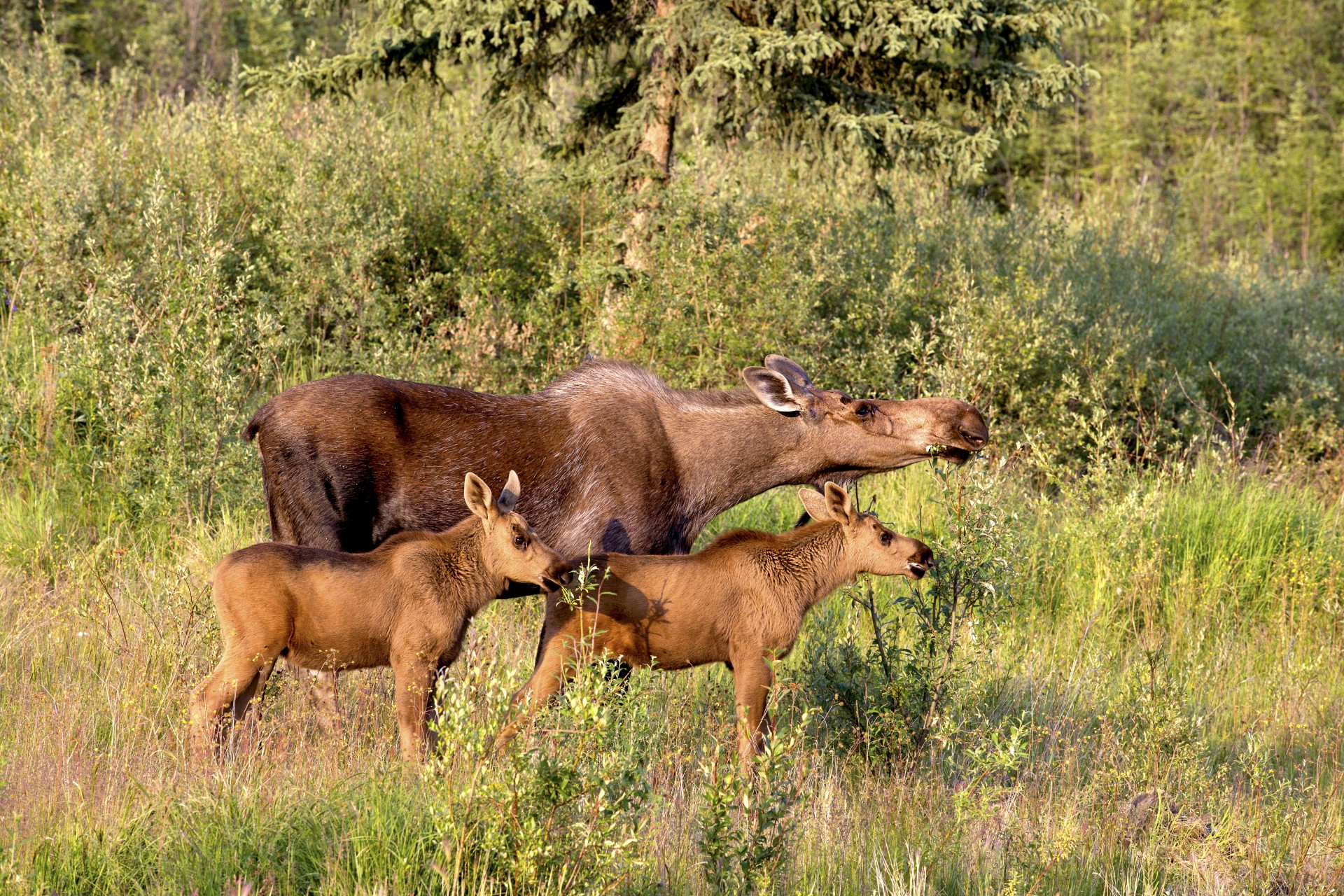Project Update
The Moose Health Project was concluded this year with the completion of PhD dissertation work by Jen Grauer in December 2024. This multi-year study included an analysis of the cause-specific survival of moose calves, where 67% of calves that died during the study experienced mortality due to infections with the giant liver fluke (Fascioloides magna). Survival probabilities were driven by moose use of wetlands where they can acquire F. magna infections, along with the number of co-infecting endoparasite species at capture. Higher monthly nutritional energy available to moose increased survival, buffering against the negative effects of endoparasite infection. Other dissertation work included summarizing information on the health status of moose in New York, from opportunistic necropsy samples and captured moose tissue samples, revealing that moose found in the state predominantly died from vehicle collisions and parasite infections. We examined competition between moose, white-tailed deer, and their shared parasites using camera trap data and parasite sampling. We found that deer exert indirect competitive pressure on moose via parasite-mediated competition. Finally, we constructed a population model to predict the effects of potential management decisions under future scenarios of varying parasite impacts.
We summarized the challenges of and findings from non-invasive approaches to understanding parasitic threats to moose in the Adirondacks. One component was the screening of aquatic habitats for environmental DNA from giant liver flukes. Of 105 sites sampled, F. magna eDNA was detected at 18 sites, including predominantly streams, ponds, and marshes. The pilot eDNA work from the moose project provides a working genetic assay to detect F. magna eDNA in these habitats, serving as the basis for future studies to optimize sampling of these important parasites.
Still Investigating
Ongoing work includes investigating factors that influence mortality risk during capture, as three of the 15 juvenile moose in the first year of capture work experienced cervical vertebrae fractures. Although the body condition of captured moose was good and the bloodwork did not indicate compromised condition, future scanning of bones for mineral density and bone ash compared to moose bones from neighboring states may help uncover whether New York moose were predisposed to fracturing.
Township locations of moose (Alces alces) necropsies in New York State conducted 2000-22.
Project Background
Moose (Alces alces) first returned to the Adirondack region of New York in the 1980s after being absent from the state for over 120 years. In order to effectively manage the population, the New York State Department of Environmental Conservation (NYSDEC) conducts population and habitat surveys to determine how many moose currently live in and can be supported by the region. To help assess population health, we examine and test samples from moose to understand reproductive status, infectious disease exposure, parasite load, and causes of death.
Despite adequate habitat and high rates of successful reproduction, the moose population has not increased as expected. Moose across New England have experienced declines from winter ticks (Dermacentor albipictus) and deer brainworm (Parelaphostrongylus tenuis), and we have detected these parasites, among others, in New York. From live and necropsied moose samples gathered between 2015 and 2017, we determined that these parasites, along with giant liver flukes (Fascioloides magna), tapeworms (Echinococcus), and Neospora caninum, are major threats to moose health. However, we do not know the extent to which these parasites may be negatively impacting the local population.
The WHP is a partner in a multi-institutional study of moose populations in the Adirondacks. Our latest project, which began in early 2021, will investigate the impacts of this suite of local parasites on moose individual and population health. We plan to capture and collar juvenile moose to determine rates of survival, assess causes of mortality, and quantify the impact of parasites on population growth. To understand the risk of infection for moose on the landscape, we will also assess parasite prevalence in intermediate (aquatic gastropod) and definitive (white-tailed deer) hosts. This will complement our previous three-year study that examined deer fecal samples and terrestrial gastropods to identify risk factors in the Adirondacks.
The WHP participates in a northeast moose health cooperative, a network that shares information and has initiated a project to identify hosts for these parasites. This information will generate a parasite risk map for moose in the Adirondacks that can help support population management programs. Additionally, we are collaborating with SUNY-ESF to develop PCR tests for Echinococcus and Neospora in canid feces to better understand these parasite cycles. All collected information will help inform moose management in New York and help ensure a healthy and sustainable moose population
LINKS
New York Moose Project
Have you seen a moose?
NYSDEC page on moose ecology
Of Moose and Men: CVM Researchers gathering key insights on New York State moose populations





